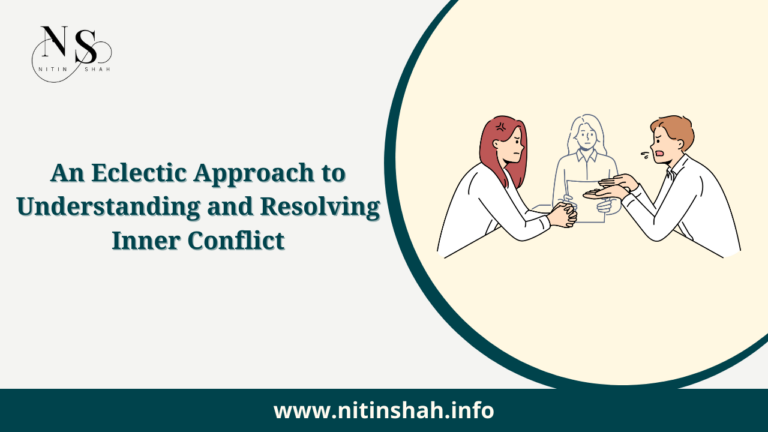Inner conflict, the clash of opposing thoughts, emotions, desires, or beliefs within an individual, is a common and often distressing experience. This internal battle can lead to emotional turmoil, confusion, and hindered personal growth. The sources of inner conflicts are diverse, ranging from unresolved issues and past traumas to societal pressures and conflicting values. Fortunately, adopting an eclectic approach to therapy provides a powerful and versatile means of helping individuals navigate and resolve these internal struggles, fostering self-awareness, emotional healing, and personal growth.
Defining Inner Conflict

Inner conflict is a multifaceted psychological phenomenon that occurs when contradictory aspects of an individual’s psyche are in discord. These opposing forces can cause emotional turmoil and a sense of being torn between different desires or beliefs. Inner conflicts manifest in various ways, such as:
- Emotional Turmoil: Inner conflicts often give rise to feelings of anxiety, guilt, anger, or sadness as conflicting emotions clash within an individual.
- Indecision: Decision-making paralysis is a common outcome of inner conflicts, making it challenging to choose between different courses of action.
- Self-Sabotage: Some individuals may unconsciously engage in self-destructive behaviors as a way of acting out their inner conflicts.
- Physical Symptoms: Prolonged inner conflict can manifest as physical symptoms like tension, headaches, and gastrointestinal issues.
The Power of an Eclectic Approach

An eclectic therapeutic approach, which draws from a variety of therapeutic techniques and philosophies, offers a comprehensive and flexible strategy for addressing inner conflicts. By combining multiple modalities, therapists can tailor their interventions to each individual’s unique needs, providing a more holistic and effective treatment. Here are some therapeutic techniques within an eclectic approach and their applications in addressing inner conflicts:
Cognitive-Behavioral Therapy (CBT):
- How it works: CBT focuses on identifying and challenging negative thought patterns and beliefs. It helps individuals recognize irrational or harmful beliefs and replace them with more constructive ones.
- Application: CBT can be used to address inner conflicts by examining the conflicting thoughts and beliefs that contribute to emotional turmoil. Clients learn to reframe these thoughts and develop healthier perspectives.
Gestalt Therapy:
- How it works: Gestalt therapy emphasizes self-awareness and integration of conflicting aspects of the self. It encourages clients to engage in dialogue between different parts of themselves.
- Application: This approach can help individuals explore and resolve inner conflicts by facilitating communication between opposing feelings or desires. It promotes a sense of unity and self-acceptance.
Inner Child Work:
- How it works: Inner child therapy involves reconnecting with and healing the wounded inner child. It aims to resolve unresolved childhood traumas and conflicts.
- Application: Inner child work can be instrumental in addressing inner conflicts rooted in past experiences. It helps individuals heal emotional wounds and gain a better understanding of their present behavior and emotions.
Mindfulness and Meditation:
- How it works: Mindfulness practices encourage individuals to become fully present and observe their thoughts and emotions without judgment. Meditation promotes inner peace and emotional regulation.
- Application: By cultivating mindfulness, individuals can gain insight into their inner conflicts. They learn to observe conflicting thoughts and emotions without becoming overwhelmed, which can lead to greater clarity and resolution.
Narrative Therapy:
- How it works: Narrative therapy helps individuals reframe their life stories and narratives. It encourages a shift from problem-focused to solution-focused narratives.
- Application: This approach can be used to reframe and reinterpret the narratives individuals have constructed around their inner conflicts. By changing the narrative, clients can adopt a more empowering perspective.
Psychodynamic Therapy:
- How it works: Psychodynamic therapy explores the unconscious processes that contribute to inner conflicts. It delves into the client’s past experiences and relationships to uncover underlying issues.
- Application: Psychodynamic therapy is particularly effective for individuals with deep-seated inner conflicts rooted in their past. By exploring these roots, clients can gain insight and resolution.
Art Therapy:
- How it works: Art therapy allows individuals to express their inner conflicts through creative expression, such as painting, drawing, or sculpture.
- Application: Art therapy provides a non-verbal outlet for exploring and resolving inner conflicts. It can help individuals access and process emotions that may be difficult to express verbally.
Family Systems Therapy:
- How it works: Family systems therapy examines how family dynamics contribute to an individual’s inner conflicts. It explores how family roles and relationships impact personal development.
- Application: By understanding the family dynamics that have influenced their conflicts, individuals can gain insight into their behavior and relationships, leading to healthier choices and resolutions.
Spiritual and Holistic Approaches:
- How they work: Various spiritual and holistic practices, such as meditation, energy healing, and chakra balancing, can help individuals connect with their inner selves and resolve inner conflicts from a spiritual perspective.
- Application: These practices can provide individuals with a sense of inner peace and spiritual insight, which can be instrumental in resolving internal battles.
Metaphor Therapy:
- How it works: Metaphor therapy uses metaphors and symbols to help individuals understand and communicate their inner conflicts symbolically. Metaphorical exploration can lead to deeper insights and resolutions.
- Application: This technique allows individuals to explore their inner conflicts through creative and symbolic means, offering a unique perspective on their challenges and potential solutions.
Parts Integration:
- How it works: Parts integration, commonly used in Neuro-Linguistic Programming (NLP) and hypnotherapy, involves identifying and integrating conflicting inner parts or subpersonalities to achieve harmony and alignment.
- Application: This technique can help individuals reconcile opposing aspects of themselves that contribute to inner conflicts, fostering inner unity and balance.
N-Step Reframing:
- How it works: N-Step Reframing, often utilized in NLP, involves understanding the positive intentions behind problematic behaviors or thoughts and finding alternative ways to achieve those intentions.
- Application: This technique helps individuals uncover the underlying motivations for their conflicting thoughts or behaviors and provides a path to address them more constructively.
Void Management:
- How it works: Void management is a technique used in hypnotherapy that guides clients in managing or controlling their internal experiences, such as emotions, sensations, and thoughts, to achieve inner calm and resolution.
- Application: This method aids individuals in regulating their inner experiences, reducing the intensity of inner conflicts, and promoting emotional stability.
Hypnotic Regression:
- How it works: Hypnotic regression involves regressing a client to a past event or age to explore and resolve unresolved conflicts or traumas.
- Application: This technique is useful for addressing inner conflicts rooted in past experiences by allowing clients to revisit and reprocess those events in a therapeutic context.
Conclusion
An eclectic approach to therapy, drawing from a diverse array of therapeutic techniques and philosophies, is a powerful means of understanding and resolving inner conflicts. The flexibility and versatility of this approach enable therapists to tailor their interventions to each individual’s unique needs, providing a holistic and effective path to self-awareness, emotional healing, and personal growth. By embracing a variety of techniques within the eclectic framework, therapists can offer clients a comprehensive toolkit for addressing inner conflicts and finding inner peace and emotional well-being. Metaphor therapy, in particular, adds a creative and symbolic dimension to the therapeutic process, facilitating a deeper understanding and resolution of inner conflicts.




